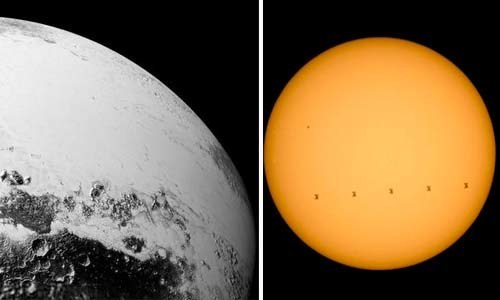

NASA is like that one friend of yours who always takes the best pictures. Last month, they gave us a rare glimpse of the dark side of the moon. And around the same time, they snapped a picture of the International Space Station as it crossed in front of the moon. And now, they’ve captured the Space Station’s solar transit and new close-up images of Pluto.
The image was taken over the weekend by NASA photographer Bill Ingalls in Shenandoah National Park in Virginia. It’s a composite image of five frames showing the International Space Station in silhouette with a crew of nine onboard as it crosses in front of the sun at roughly five miles per second. Talk about split second timing for that shot.
“Not unlike a rocket launch, there is a lot of prep work that goes into making a photo that is only a thousandth of a second or less,” Ingalls told The Huffington Post. “This total solar transit was only 0.6 of a second in length and I was lucky to get five frames shooting at 10 frames per second.”
Ingalls also took the image of the Space Station’s lunar transit last month. This one was taken from Woodford, Virginia.
If that wasn’t enough to delight your inner space geek, just yesterday NASA released its new close-up images of Pluto taken by New Horizons spacecraft. The images have scientists “reeling” because of the “variety of surface features” on the icy dwarf planet.
“Pluto is showing us a diversity of landforms and complexity of processes that rival anything we’ve seen in the solar system,” said New Horizons Principal Investigator Alan Stern, of the Southwest Research Institute in Boulder, Colorado. “If an artist had painted this Pluto before our flyby, I probably would have called it over the top—but that’s what is actually there.”
It’s complicated… Pluto’s surface, that is. New close-ups from @NASANewHorizons #PlutoFlyby: http://t.co/gAjyhdHTmZ pic.twitter.com/HVRn2SBXw9
— NASA (@NASA) September 11, 2015
The images reveal “new features as diverse as possible dunes, nitrogen ice flows that apparently oozed out of mountainous regions onto plains and even networks of valleys that may have been carved by material flowing over Pluto’s surface,” says NASA. “They also show large regions that display chaotically jumbled mountains reminiscent of disrupted terrains on Jupiter’s icy moon Europa.”
Scientists are positively giddy (and puzzled) about the images. “Seeing dunes on Pluto—if that is what they are—would be completely wild, because Pluto’s atmosphere today is so thin,” said William B. McKinnon, a geology, geophysics and imaging deputy lead from Washington University in St. Louis. “Either Pluto had a thicker atmosphere in the past or some process we haven’t figured out is at work. It’s a head-scratcher.”
YOU MIGHT ALSO LIKE
NASA Captures ‘EPIC’ Image of the Dark Side of the Moon
What Is a Blue Moon and Where Did It Get Its Name?
Devastating Wildfires Are Even Changing the Appearance of the Moon

 233k
233k  41k
41k  Subscribe
Subscribe 

